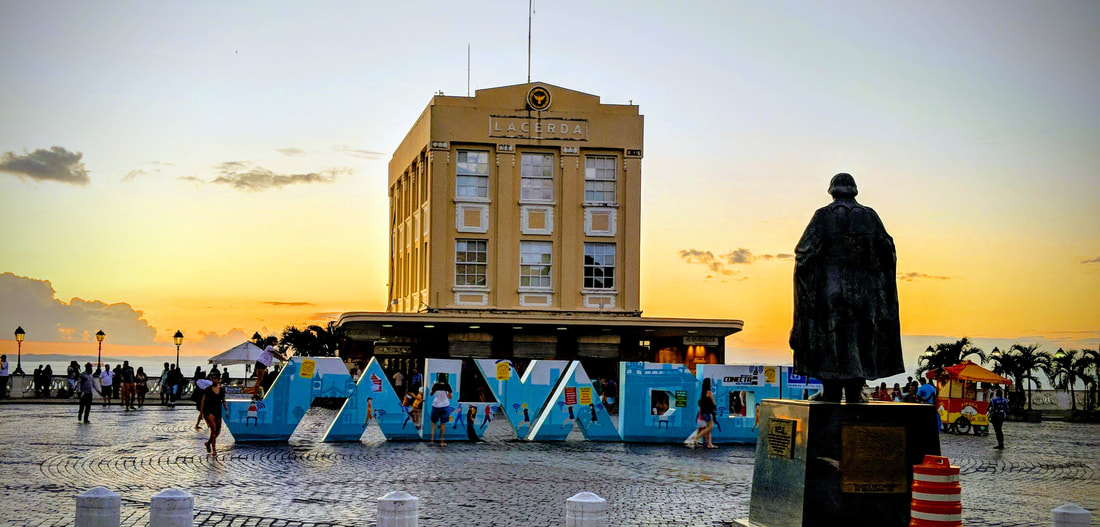|
By Brianna Kreft On our first weekend in Brazil, we made a trip to Lençóis, a small town in central Bahia. We did everything from hiking, to dancing, to swimming, to watching capoeira. We even managed to fit some political science in there too. The weekend’s activities highlighted the racial differences between rural and urban areas in Bahia, Brazil. We also learned a bit about the geography and history of the area. After about a six-and-a-half-hour ride on our Mariah Carey bus (a coach bus with a rainbow plastered on the side), we hit the ground running in Lençóis with a hike through a section of the Chapada Diamantina National Park. Here, we took in our first views of the city and learned about the history of Lençóis. The city of 12,000 people was originally founded as a diamond mining town. On our hike, we learned that after years of diamond extraction, the mining industry halted. Now, the area is protected as a national park. Yet, an important “political science” thing to point out is that this does not mean the same protection we would expect of national parks in the United States. Brazil’s national park system is not as comprehensive or popular as America’s. It offers limited environmental protection, and the private sector still has major influence over protected areas. Chapada Diamantina National Park now serves as an attraction for Lençóis, which is important as Lençóis’s only industry is tourism. This points out an inequality between rural and urban areas in Brazil. Salvador, the city we are living in during our trip, is a city of almost 4 million people and very urban, while Lençóis’s population is only 12,000 and quite rural. Like rural areas in the United States, Lençóis is less connected and has fewer resources than Salvador. Yet, Aécio, our guide, said that rural areas in Brazil are much less connected to other cities than rural areas in the United States. He said that some rural areas only received internet access within the last two years and that broadband can be difficult to come by in smaller towns. Overall, resources are harder to come by in rural areas like Lençóis than in urban areas like Salvador. With this comes inequality. Another aspect of this inequality is the variety of industries between the two cities. Salvador boasts many kinds of industries including food and tobacco processing, textiles, ceramics, automobile manufacturing, chemical production, woodworking, leatherworking, and shipbuilding. On the other hand, Lençóis’s only industry is tourism. This limits opportunities for people living in rural areas compared to those living in urban areas in Brazil. “Hiking” was the key word to describe our second day in Lençóis. We hiked up Pai Inacio Mountain in the morning for some breathtaking views of the Chapada. Our amazing guide, Aécio, told us the story of how the mountain got its name, which depicts some interesting historic racial dynamics. The story goes that a colonel married a French woman, but the colonel had sex with one of the female slaves (probably not consensual—yikes!), and she birthed a son named Inacio. The colonel was the only person who knew that Inacio was his son, and he grew up as an enslaved person. When he was older, Inacio fell in love with the colonel’s wife, and soon the wife fell for him as well. The two snuck around as best they could, but the colonel discovered them. He went into a fit of rage, and Inacio fled to the top of the mountain. The colonel’s men began to surround him, and seeing that he would be captured, Inacio leapt from the top of the mountain, with the French woman’s umbrella. When the men reached the top, all they saw was the abandoned umbrella, and assumed Inacio died. Yet, Inacio landed in a hidden cave in the mountain, and survived. He later found the French woman and they ran into the sunset together and lived happily ever after (Cue cheesy montage music). I share this story not only for fun, but also because it represents how history has been passed on orally in Brazil, and how the enslaved people in Brazil were able to carve out their own path despite having been ripped from their homes and people. This same day, we also hiked into Lapa Doce Cave and to a waterfall, where we were able to take a refreshing dip. Later that night, after a delicious dinner, we hit the town! Lençóis was having a town celebration, so we danced with locals and were able to observe firsthand a major racial difference between Lençóis and Salvador—Lençóis had a less racially diverse population than Salvador. At the town party, I saw that the majority of people in Lençóis were what Americans would consider Black, whereas in Salvador, I have seen what we would consider Black, mixed, and white people. I remember Pedro saying that rural areas tend to have higher Black populations. I definitely saw this on our trip to Lençóis, where we saw relatively few Moreno or white people. This is an interesting dynamic, because it is the opposite of the United States, where rural areas tend to be predominantly white. The next day, we packed into our Mariah Carey bus to make the trip back to Salvador. Lençóis offered us the opportunity to not only try cachaça, go hiking, and explore a beautiful city, but it also taught us another layer of racial dynamics here in Brazil.  Brianna Kreft is a senior at CSB/SJU, majoring in Political Science, and minoring in Environmental Studies and Psychology. She is originally from Elbow Lake, Minnesota. Brianna enjoys learning about gender issues and women’s empowerment. She has participated in multiple research opportunities focused on gender-related social justice issue. Brianna looks forward to being able to learn more about the country that she has been researching for the past two years.
0 Comments
Leave a Reply. |
Archives
June 2024
Categories
All
|

 RSS Feed
RSS Feed
